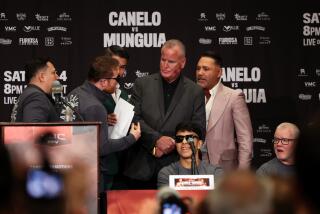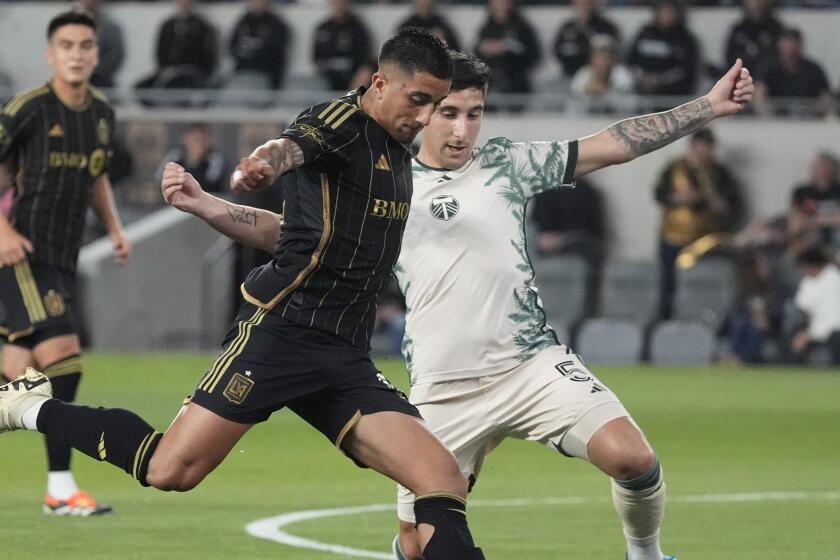BASEBALL / ROSS NEWHAN : Tigers Traveling on a Rocky Road
Even before major league owners initiate a new revenue-sharing plan, the Detroit Tigers may soon qualify for federal relief funds.
A disaster?
“I’m embarrassed by how we’re playing, but I’m not embarrassed about the direction we’re going in,” General Manager Randy Smith said by phone.
The Tigers’ current direction is due south, deeper into the American League East cellar with a record straight out of the Metsonian era of the early ‘60s.
A pitching staff that includes six surgically repaired arms is giving up runs and home runs in record numbers, but Smith and the Tigers are committed to building from within, starting with the rebuilding of a farm system that failed to restock Sparky Anderson’s veteran teams of the ‘80s and offered so little promise that Anderson didn’t fight the suggestion that he work on his putting full time.
“It didn’t get this way overnight, and it’s not going to be fixed overnight,” Smith said of the Tigers, from the major league level down.
“If there was a quick fix out there, we would have found it, but we’re not going to mortgage the future for a few more wins in 1996.
“What we’re experiencing right now is painful, but I think our fans have bought into the concept that if we’re going to rebuild virtually from scratch, let’s do it right.”
In the meantime:
--The Tigers are 0-2 in a weekend series against the Cleveland Indians--a mismatch resembling something out of the Colosseum in Rome--with a 12-37 record, having lost 30 of their last 34 games. The record projects to 40-122, record numbers for a 14-team league and worse than the Mets’ 40-120 debut in 1962.
--With his 10 wins for the Atlanta Braves, former Tiger John Smoltz has more victories than Detroit starters combined. The staff earned-run average of 7.26 threatens to break the major league record of 6.70, set by the Philadelphia Phillies of 1930, and Tiger pitchers are on a pace to easily shatter the major league record for runs and home runs given up in a season. The Chicago White Sox scored 41 runs against the Tigers in a three-game sweep last weekend, and the Tigers have given up 10 or more runs 14 times.
“We knew when we evaluated the club and system that it would be a great challenge, but we didn’t think the team would play this badly,” Smith said.
“The problem is that no one has played up to or above his ability aside from [second baseman] Mark Lewis.
“The three veterans that form the heart of the team [Chad Curtis, Travis Fryman and Cecil Fielder] have not gotten untracked.
“We knew we wouldn’t be world beaters, but we expected to play better.”
The overhaul began with management: a new general manager and a new manager in Buddy Bell.
Smith came from a similar position with the San Diego Padres, where he had to conduct much of owner Tom Werner’s fire sale of talented and high-salaried veterans, while also laying a foundation for the competitive team of 1996.
Only a week into the regime of new owner John Moores in December of 1994, Smith negotiated the 12-player trade with the Houston Astros that brought three starting position players--Ken Caminiti, Steve Finley and Andujar Cedeno--to San Diego.
The Padres held a contract option on Smith and ultimately said they would exercise it, but the delays convinced Smith that he and new club President Larry Lucchino “didn’t see eye to eye” on many issues, making for an uneasy and uncomfortable situation, and Smith’s winter departure for another daunting challenge.
The Padres basically turned it around in three years, but Smith isn’t sure that time frame applies in Detroit. It could take longer.
“We started 10-32 in 1994 and everyone in baseball was laughing at us,” Smith said. “But we were the most improved team in the National League last year, and now the Padres have a chance to win their division. Unfortunately, we don’t have the depth or tradeable players in our system that we did in San Diego. It’s been proven that scouting and development works, but it takes time.”
Smith will try to accelerate the process this week. He called up his top position player, catcher Raul Casanova, on Friday, and is expected to soon call up the top pitching prospect, Justin Thompson.
The Tigers are headed to a new stadium in 1998 or ‘99, and Smith hopes to design a civic and competitive renaissance comparable to Cleveland’s.
“We intend to stick with the plan,” he said, the Tigers obviously at a loss--a lot of them--to consider anything else.
THE RIPKEN MOVE
If the Baltimore Orioles move Cal Ripken Jr. to third base, it probably will happen Tuesday night in Seattle, a long way from the crush of the hometown media.
There also seems to be more to this than an opportunity to look at future shortstop Manny Alexander while third baseman B.J. Surhoff is on the disabled list.
The new management team of Pat Gillick and Davey Johnson seems to be saying that nothing will impede the attempt to put their best team on the field every day.
They will not discard Ripken’s consecutive-game streak, but his pride may have to be sacrificed now and then. They have already batted him seventh and removed him for a pinch-runner in a game still to be decided. And there seemed to be much in what Gillick did not say when he said:
“This team hasn’t won since ’83. I’m not so sure the nucleus here knows how to win. Basically, there’s a certain ingredient that goes into winning, and it might be that this group hasn’t found that ingredient and they have to find it. . . .
“A team approach before an I or me approach, consistently doing things that . . . don’t show up statistically but, bottom line, help you win games.”
Gillick said he wasn’t talking about Ripken, but Ripken, as the Orioles’ last link to ‘83, didn’t care for the insinuation.
“I think it would be really unfair if anybody pointed a finger at me and said I wasn’t a team player,” Ripken said in Baltimore.
“There’s not one point in my career [when] I haven’t been willing to do what’s been asked of me. I challenge you to find one example.”
It is also believed that Ripken was not pleased that Johnson boxed him into the move to third by first discussing it privately with him and then immediately telling reporters about it and saying Ripken would go along.
“We talked about a lot of things--how well the club is playing, how much of an impact a move like that would make, how that would affect the overall stability of the club, a lot of general things,” Ripken said. “It was left open-ended, and then it turns into a media event.
“The issue, however, is basically clear. Whatever the manager asks me to do, I will do. A player is a player and a manager is a manager.
“If you cut through all the media hype, all the things you guys like to analyze and dissect, there is no issue.”
RIPKEN II
Ripken is not a stranger to third base. It was his original position before then-Oriole manager Earl Weaver moved him to shortstop in 1982. He also played third base briefly in spring training of 1989.
Former teammate Jim Palmer, now a club broadcaster, said he thinks Ripken has lost some quickness at shortstop, but scouts say Ripken’s forte has always been positioning rather than quickness and range. And second baseman Roberto Alomar, who signed with the Orioles in part because of the opportunity to play next to Ripken and is having one of his best seasons, doesn’t want the move to happen.
“I can tell you, I’m having a lot of fun with Cal beside me,” Alomar said. “I hope he stays there. He’s helped my game, and I think I’ve helped his in the same way.”
NAMES AND NUMBERS
--If the Ripken move proves to be more permanent than temporary, Surhoff would probably become the designated hitter, making Bobby Bonilla expendable. Bonilla has railed about his unhappiness with the DH role and the uncertainty of his daily situation with the Orioles, and this week delivered an expletive-laced speech directed at Johnson, characterized by the question “What the . . . is going on around here?”
--While Marge Schott hands out business cards that read “no comment,” her Cincinnati Red manager, Ray Knight, offered his resignation after a sixth consecutive loss Monday but was rejected by General Manager Jim Bowden, who said: “I told him to check out Tony La Russa and Jim Leyland. They are the best managers in the game and neither one has won anything for a while. . . . We’re still close to the top, and all that counts is how good you are at the end of the year.”
--The failure of the Houston Astros to take control of the Central race drew a blast from both General Manager Gerry Hunsicker--”I will not accept mediocrity”--and Jeff Bagwell, who said: “Sometimes I think we have guys who are just going through the motions, and that isn’t going to cut it here. Sometimes it’s like we have nine different guys out there doing nine different things. It’s ridiculous the way this team has looked.”
--With Lenny Dykstra joining Darren Daulton, Gregg Jefferies and five other players on the disabled list, the Philadelphia Phillies are committed to $17.5 million in base salaries to the eight sidelined players and $12.5 million to the 25 players on the active roster.
--One of Fred McGriff’s best starts includes his 300th homer and a .330-plus batting average. The Atlanta Braves will need their first baseman to continue picking up the slack created by David Justice’s dislocated shoulder. Said McGriff, up for the task: “My baseball card might say I’m 32, but I feel 25, 26.”
--Edgar Renteria, who replaced Kurt Abbott as the Florida Marlins’ shortstop this week, is the youngest player in the majors at 20, 11 days younger than Seattle Mariner shortstop Alex Rodriguez. Comparing Renteria to New York Met rookie sensation Rey Ordonez, Florida’s Latin America operations director Al Avila said: “Forget about Ordonez. As a shortstop, [Renteria] is second to none.”
More to Read
Get our high school sports newsletter
Prep Rally is devoted to the SoCal high school sports experience, bringing you scores, stories and a behind-the-scenes look at what makes prep sports so popular.
You may occasionally receive promotional content from the Los Angeles Times.






